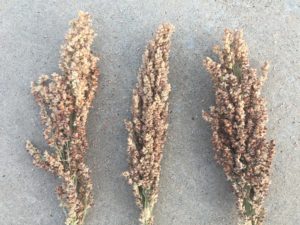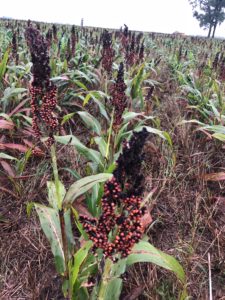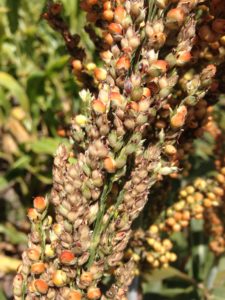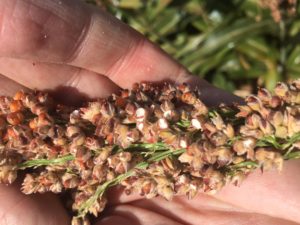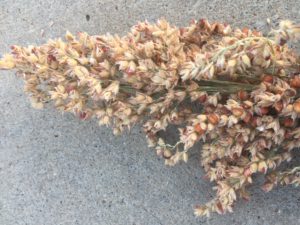Dr. Calvin Trostle, Extension Agronomy, TAMU Soil & Crop Sciences, Lubbock,
(806) 723-8432, ctrostle@ag.tamu.edu
This past week I received digital pictures and sorghum head samples from two different fields where grain sorghum fill was incomplete. This highlights the most difficult field situation I encounter in grain sorghum for 20+ years. What is the cause? What is particularly frustrating is production conditions often appear to be good. Often it is difficult to pinpoint any reasonable cause. Weather often is not a known factor, e.g. there were no extremes of hot or cold temperatures, and there is no obvious explanation due to insects.
When trouble shooting issues involving grain sorghum fill first remember that grain sorghum heads flower from the tip downward. For a typical sorghum head that is 6 to 8 inches long, this could require up to a week. So, if heads are partially filled then the location of the blank area might be a possible clue to what happened, if the top or the bottom is partially or fully blank. Also, if I am in the field, I look for signs of grain fill differences between the primary head and tillers, which tend to trail the main head in flowering by a few days to a week.
Most often I receive pictures or the blank heads themselves (Fig. 1). Visiting the field sometimes can be helpful if there are patterns in the field, but usually I don’t have the opportunity to observe the field itself.
When a head is nearly completely blank, but growth of the field is good (Fig. 2—notice good vegetation in background), where do we start?
Factors for incomplete grain fill may include:
- Temperature, either cold or hot;
- Insect damage, especially sorghum midge and possibly spider mites. Sugarcane aphid will cause a lack of grain fill, but this cause is obvious as there will be high aphid populations so there is no mystery about lack of grain fill.
- Application of growth regulator herbicides (e.g., dicamba, 2-4-D);
- Bird feeding;
- Diseases
Fig. 1. Varying degrees of blank heads from lack of fertilization, pest damage, environmental, or other factors. Middle head is mostly blank. Some small seed is found. (Lubbock, TX 2019.)
Fig. 2. Near complete blanking of grain sorghum head with no obvious cause in otherwise good growing field with a proven hybrid. No dicamba or 2,4-D was applied. (Lubbock, TX 2019.)
Cold Temperatures
From an August 2009 e-newsletter Kansas State agronomists discuss the effects of temperature, both hot and cold. Most of the KSU discussion focuses on cold temperatures ≤55ºF during pollen formation, which occurs from about flag leaf emergence to flag leaf collar development (hence a fully-grown leaf). This temperature may induce pollen sterility thus reducing seed set. I don’t think this is a potential issue anywhere in Texas. We just don’t have this type of night-time temperature on early sorghum, as this point of pollen development is likely at least 45 days after planting for a medium-early hybrid. If this were an issue in the fall, then it represents a grain sorghum hybrid maturity/planting date combination that is so late that mature grain harvest is in serious doubt.
KSU also notes that as pollination begins temperatures near 50ºF can slow pollen germination and growth. But pollen survive and remain viable even to about 40º. Again, this would only be a possible scenario in Texas for late-planted grain sorghum. When needed heat units are factored in from flowering to maturity, for example, these temperatures would be needed in the immediate Lubbock area by about Sept. 10 to impact otherwise normal flowering and grain development that would to confidently reach full maturity in the fall. Lubbock’s average low nighttime temperature for Sept. 8 and 9 is 62º, and the record lows for these two days are 45º and 47º.
Even if temperatures reach these lows early or late in the year, the presence of many individual plants throughout the field, and slightly delayed formation of pollen in tillers, suggest that it would take a major cold weather event to affect all pollen in the field. For further reading on KSU’s cold temperature comments see the reference below.
Hot Temperatures
In general, grain sorghum has relatively low susceptibility to poor pollination during hot temperatures (Fig. 3). AgriLife has little concern about these temperatures to the low 100ºs. This is part of why grain sorghum is a heat tolerant, drought tolerant crop relative to corn. Corn’s vulnerability is to hot temperatures not only a potential issue with pollen, but possible damage to silks or inability of the pollen to grow through the silk if desiccated. Over the years we have attributed possible blanking of heads where we believed temperatures may have been 105º or higher, but we can’t be certain. We are not sure about the same hot temperatures’ effect on pollen formation. I have seen evidence of poor seed set in the middle of larger heads (an irrigated field) where we believe that hot temperatures may have stifled pollination for 1 or 2 days leaving a gap of poor seed set in the middle of the head.
Fig. 3. Believed heat damage from Central Texas on grain tips. Since tiller heads are likely later by a few days, the symptom was not found on tillers. The black sooty appearance is likely secondary pathogen infection (not the cause of the blanking). (Photo courtesy Ron Schnell.)
Insects
Sorghum midge. The most obvious concern is this small gnat-like insect which is attracted to flowering sorghum (Fig. 4). The insect lays eggs in individual florets at flowering, and the developing larvae then thwarts seed development. This gives the head a blasted appearance, but in general there will be individual grains that still fully develop as sorghum midge does not normally affect every seed (Fig. 5). The level of blanking will reflect the midge infestation level. If midge is the culprit and you are examining a field after damage has occurred (midge may be gone), then a small magnifying glass may help you identify pupal casings. Sorghum midge, however, is generally only suspected for later flowering grain sorghum. According to the Texas A&M AgriLife Extension guide “Managing Insect and Mite Pests of Texas Sorghum” the general “flower by” dates after which sorghum midge becomes a more likely damaging pest ranges from about May 10 in the Lower Rio Grande Valley to August 1 in
the High Plains. If you have unexplained blanking and your sorghum flowers after these dates, then in your next grain sorghum crop you should scout closely for sorghum midge. Since I have been in Lubbock with Texas A&M AgriLife, only one year has there been reports of significant sorghum midge and spraying. It is possible that some producers are missing low and even modest levels of midge as sorghum midge is not being scouted for.
Fig. 4. Adult sorghum midge on a grain sorghum floret during egg lay. (Photo courtesy Texas A&M AgriLife Extension Entomology).
Fig. 5. Sorghum midge damage to numerous florets with other florets that developed seed. Sorghum midge damage relative to insecticide sprays is sporadic as the insects hatches daily. (Photo courtesy Ron Schnell.)
Spider mites. According to the above AgriLife sorghum insect guide the other insect issue that may affect grain development is Banks mites or two-spotted spider mites. These insects are more common in drier areas of Texas. If the mite infestation is high during early kernel development, plants are less able to make and fill grain. This could also create a blank appearance in the head.
Other sorghum kernel-feeding insects—do not inhibit grain initiation. Corn earworm and fall armyworm can feed heavily on grain sorghum, often leaving the starchy portion of the kernel exposed (Fig. 6). These worms, along with webworms in the more humid areas of Texas, may feed initially on floral structures and then on developing grain. This type of damage is generally distinguishable from outright blanking in the head. Head-feeding bugs of Texas sorghum that may feed on developing grain, also include rice and other stink bugs (Conchuela, southern green), false chinch bugs, leaffooted bug, and lygus. These insects are more likely to suck out internal seed components vs. the feeding of CEW and FAW. Close inspection with a hand lens can reveal feeding damage that is otherwise difficult to see.
Fig. 6. Empty glumes and irregular feeding pattern (right arrow) indicate sorghum webworm feeding of three or more worms in the image. (Photo courtesy Ron Schnell.)
Growth Regulator Herbicides
Dicamba and 2,4-D applications in grain sorghum require specific guidelines for rate, timing, and application method of the herbicide based on grain sorghum growth stage. These guidelines usually stipulate a height or leaf number.
For both herbicides the label instructions are the same: do not apply before 5” tall (leaf stage 3 to 5), and if >8” to 15” tall then use drop nozzles to keep the chemical off the foliage as much as possible and especially out of the whorl. This stage of growth is tied closely to the initiation of the panicle or head down inside the plant. Usually at about 30 days the growing point differentiates from producing another leaf to developing the head and the number of potential spikelets and seeds per spikelet. This is an important component of yield potential.
Dicamba or 2,4-D down in the whorl has a significant chance to damage grain development of the head. Seed will not be initiated (I am unsure if pollination even occurs). This can lead to significant blasting of the heads (appearance like Fig. 2). Labels reiterate keeping the chemical off the plants later as well to ensure no risks to the head. Drift rates of dicamba from dicamba-tolerant cotton are not expected to significantly impair grain development at low or even moderate levels, but grain sorghum that is adjacent to the target cotton spray area is certainly at risk if the growth stage is sensitive.
Bird Feeding
Different species of birds will feed on grain sorghum starting as early as about 10 days after flowering is complete. This does not result in the broad blanking one may find from other causes. Furthermore, you will readily notice pieces of grain resting on lower leaves adjacent to the stalk and on the ground. Birds can clean out a field, but then you will likely have noticed the feeding, so it is no mystery if the field is missing a lot of grain.
Diseases
Dr. Gary Odvody, plant pathologist, Texas A&M AgriLife Research, Corpus Christi, notes that there are no plant diseases in grain sorghum, at least by themselves, that are likely to cause blanking in the head. There are some opportunistic fungi that may infect small stressed kernels thus consuming the seed, but this usually requires some sort of stress condition like drought, severe iron deficiency, etc.
The above KSU document also notes some darkened heads that have moldy or sooty conditions, but this is a result of other factors (high humidity, wet conditions) and is not the cause of blank heads or small seed. Fungus that is consuming kernels may reduce seed size as a component of weathering but are not the original source of the problem.
Small Seed Syndrome
Dr. Odvody notes what is generally called small seed syndrome in grain sorghum (Fig. 7). It is a case, though, where there could be several factors that may be responsible. The one he is most familiar with near the Texas Gulf Coast is likely related to iron chlorosis, often in particular hybrids. Stress conditions like drought may compound the issue. Other small seed could be due to insect feeding like stinkbugs which penetrate and extract internal seed contents (feeding) which then leads to smaller seed. A hand lens will likely reveal the feeding damage on the seed.
Fig. 7. Small seed and incomplete development. Seed is not shriveled in appearance when removed from glumes (two glumes enfold each kernel) which might suggest insect activity. Unidentified stress conditions may have led to lack of grain fill, but these florets were pollinated. (Lubbock, TX 2019.)
The Most Common Head Blanking Pattern
This is Trostle’s observation. Over many years, the most common pattern I see—and one that farmers often do not bother to bring to my attention—is simple partial blanking in the top of the head (Fig. 8). Usually we can eliminate concerns about heat, and the timing suggests that often sorghum midge could not be a factor since it is early in year. If you as a farmer or consultant experience the same uncertainty I do, I welcome your e-mail comments and digital pictures about field symptoms you have experienced.
Fig. 8. Most common grain sorghum symptom—lack of grain fill or small seed—on the tip of the sorghum head. (Lubbock, TX 2019.) (Lubbock, TX 2019.)
References
Possible causes of blank heads in grain sorghum. 2009. Agronomy E-update #214 (Oct. 14). Kansas State Univ., Manhattan, KS. (https://www.agronomy.k-state.edu/documents/eupdates/eupdate101609.pdf)
Managing Insect and Mite Pests of Texas Sorghum. 2018. ENTO-085. Texas A&M AgriLife Extension Service, College Station, TX. (https://agrilife.org/extensionento/resources/management-guides/sorghum/)
September 2019
